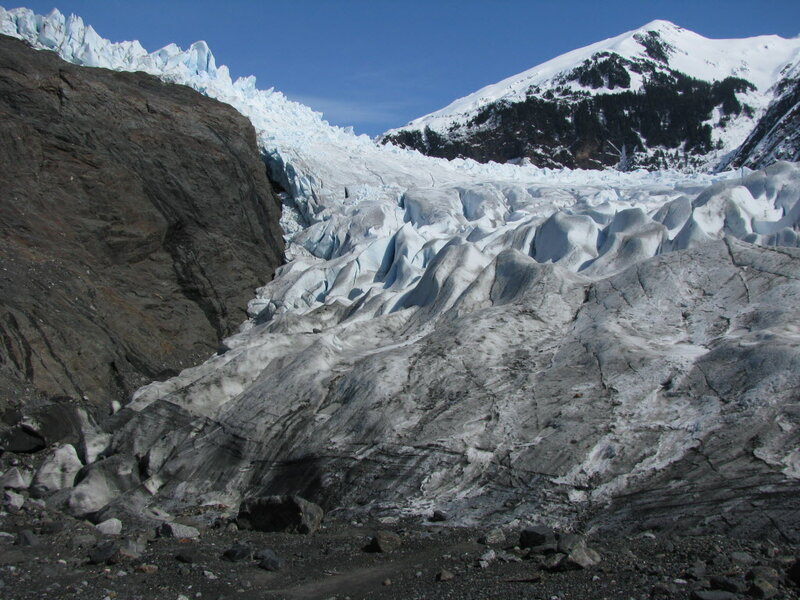What triggered the massive Glacier Bay landslide?
Loading...
It was several hours after sunrise and some 4,000 feet up in the mountains that rib Alaska’s Glacier Bay National Park that a rock face the size of nearly 250 football fields collapsed. The rocky, crumbling mountain face slid down the steep slope for over a mile, picking up more and more speed as it went. Then it reached the Lamplugh Glacier, which lay beneath the high, steep rock face of the mountain.
Snow and ice from the glacier were caught in the acceleration of the rocks and debris that continued to plummet onwards, turning into a massive landslide of 120 million metric tons of rock face and glacier. Finally the moving earth came to a stop, some six miles from the site of the collapse.
At least that is the initial picture mapped out by the scientists who study this vulnerable region of Alaska, who registered the remote landslide in seismic recordings. It is also what pilot Paul Swanstrom saw, flying over the dust cloud caused by the landslide several hours later. He told local station KTVA that it was one of the largest landslide he'd seen in three decades of flying in the area, describing it as "six and a half miles long, a mile or two wide and probably 100 feet thick."
Had the massive landslide continued another ten miles, to the end of the glacier, it would have slid right into Johns Hopkins Inlet, a popular spot for Alaskan cruise ships.
That is an outcome the scientists fear as they look at the fragility of the landscape in Southeast Alaska’s mountains, which Columbia University geomorphologist Colin Stark calls a “global hotspot” for these landslides. Just last year, a similar landslide did hit water, sliding into the Taan Fjord and creating a tsunami that ran 600 feet up the fjord, stripping the trees.
“It’s just a matter of time and space when another landslide will strike,” Dr. Stark who studies landslides in the region along with seismologist Göran Ekström and their team at Columbia University’s Lamont-Doherty Earth Observatory, said in a statement. “The thing that really got me: If it just happened a bit further over, near the calving front, that would be a very bad thing. You can see in Google Earth – that’s a cruise ship right there. If the landslide had been closer, it likely would have dumped some debris in the inlet.”
These massive, mountain landslides, which typically happen between three and five times each year around the world, are caused by a combination of factors. One is geological: as tectonic plates shift, the mountains are pushed ever higher. It’s the same phenomenon that keeps the Himalayas growing about a centimeter per year. But tectonic activity also creates movement that can lead to landslides and earthquakes.
But the compounding factor is environmental: retreating glaciers.
Glaciers used to act almost like a cement for the area – they once spanned entire valleys between mountains, their weight turning sediment into the rock that walls the valleys. But, as Columbia’s Earth Institute explains, as the glaciers shrink they expose the rock faces that they used to hold in place, making them more vulnerable to collapse.
Shrinking glaciers are a global phenomenon caused by the heating up of the planet, and Alaska has seen stunning change as the state’s average annual temperature increased at double the rate of the rest of the country. With more than 100,000 glaciers in the state, 95 percent are currently “thinning, stagnating, or retreating,” including most of Glacier Bay’s glaciers, according to the National Parks Service.
These long-term causes of landslides, both environmental and geological, are known. And Stark and Dr. Ekström have been developing a seismic data technique that enables them to identify landslides as they are happening and then work backwards to figure out a landslide’s mass, speed, and distance traveled. Researchers from other universities as well as the National Park Service and the US Geological Survey are studying different effects of recent landslides in the area.
But what scientists are less clear on is what, at a particular moment on a particular day, triggers the start of a landslide. They hope that studying the recent landslides, like the one that caused a tsunami in Taan Fjord last year, will begin to uncover some of these answers, as well as how best to plan for and anticipate the landslides.
“Putting this in geological context is really important,” said Stark, who will be leading a research team in Glacier Bay Park this summer. “These walls are failing by the very nature of the process.”





